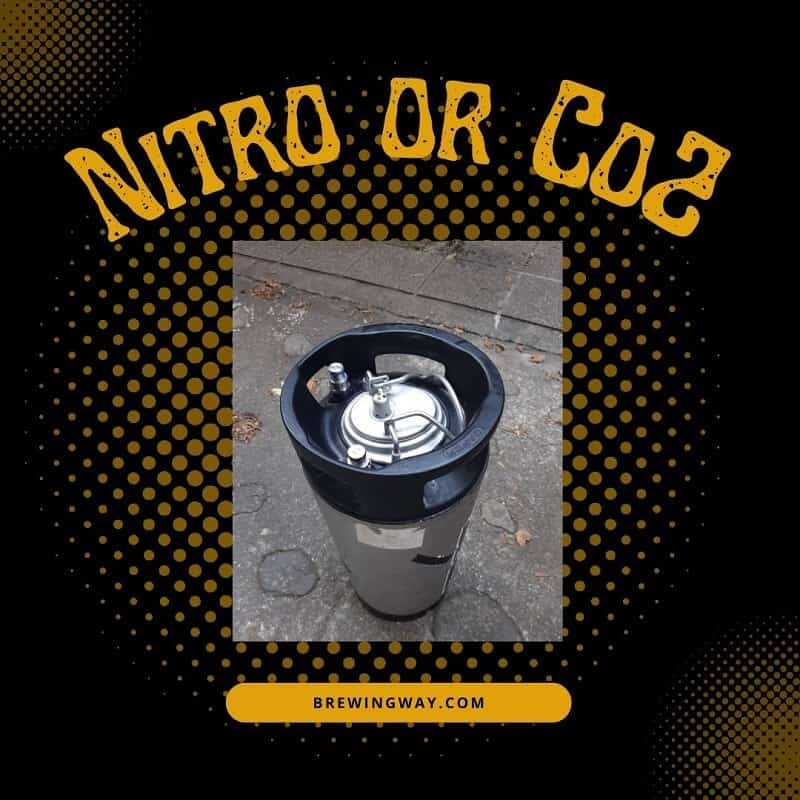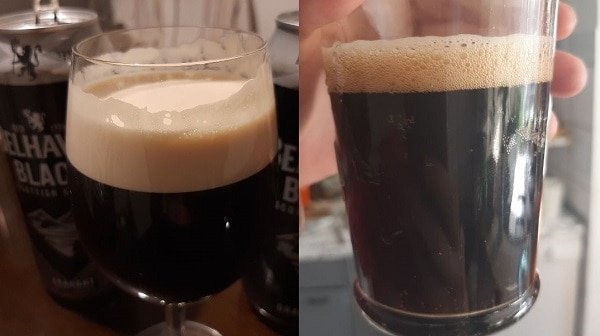
Homebrewing is a popular hobby for beer enthusiasts, allowing them to create unique and flavorful brews right in the comfort of their own homes.
When it comes to carbonating your homebrew, two options stand out: CO2 (carbon dioxide) and Nitro (nitrogen).
Co2 might be the most popular gas as it’s an ingredient in most beer styles, yet many homebrewers underestimate the benefits of using Nitrogen.
In this guide, we will explore the differences between CO2 and Nitro in homebrewing, their effects on beer, and how to choose the right method for your brew.
Understanding CO2 in Homebrewing
CO2 is the most commonly used method of carbonation in homebrewing. It is a natural byproduct of the fermentation process and can be added to the beer in various ways.
The first, and easiest one is the natural carbonation within a bottle or a keg, and the other is the forced carbonation.
Natural carbonation with Co2
Natural carbonation is the method, that most homebrewers are familiar with and is the best beginner method.
To naturally carbonate beer, a homebrewer needs to bottle and add a small amount of priming sugar to reactivate yeast in the bottle or a keg.
This method goes nicely with beer conditioning because the time required for beer carbonation within a container is also sufficient for beer to mature to at least 1/3.
Some beers need to remain in storage and age for a week, more weeks or months depending on the beer style.
Forced Carbonation with CO2
When using the forced carbonation method, homebrewers typically transfer their beer into a keg and introduce pressurized CO2 gas from another keg or a Co2 cartridge. The CO2 dissolves into the beer, creating the desired level of carbonation in no time. This method is known as forced carbonation and it’s the favorite method of almost every commercial brewery.
Benefits of forced carbonation:
- Quick carbonation (no waiting time)
- Faster output for breweries (beer is ready for consumption sooner)
- Easier and automated process (no manual handling and measuring of priming sugar which can lead to mistakes)
I would highly recommend the forced carbonation method if you have been homebrewing for some time, but if you are a beginner and don’t like additional expenses, stick to the natural carbonation method.
Benefits of CO2
CO2 is readily available and widely used, making it easily accessible for homebrewers. While the prices of Co2 aren’t high, the natural carbonation is completely free, as you only need to spend a few dollars on corn sugar.
Co2 fits every beer style, and based on the Co2 volume you control, you can satisfy everybody’s taste.
Unveiling Nitro in Homebrewing
Nitro, short for nitrogen, is an alternative method of carbonation that produces a unique and creamy mouthfeel in beers. Nitro beers are known for their smooth and velvety texture. Probably the most famous example of a nitrogen-based beer is the famous Guinness which extracts most of its charm from nitro.
Moreover, nitro can enhance porters, IPAs, Fruity ales, and likely some other beer styles.
Carbonation with Nitro
To carbonate with Nitro, homebrewers use a blend of nitrogen and CO2 gases (usually 70-30 or 80-20 in favor of nitro). This blend is commonly referred to as “beer gas” or “nitrogen gas.”
It’s not recommended to use nitro only, because nitrogen is poorly dissolved in a liquid which results in a nice-headed but flat beer straight after the pour. Some Co2 in the mixture is required to counterfeit this problem, as Co2 is easily dissolved in a liquid and will remain in a beer for quite some time after pouring.
Together, the mixture of these two gases which favor nitro, creates a foamy, delicious, and everlasting head, with minimal but noticeable carbonation which adds to the beer body feeling and sparking sensation.
For this method to work, the beer is forced through a restrictor plate or a nitrogen infusion system which creates tiny bubbles and a cascading effect. (Nitrogen bubbles rapidly go towards the surface, while Co2 remains in the beer due to its heaviness).
Benefits of Nitro
Nitro carbonation offers distinct advantages for certain beer styles. It imparts a smooth and creamy texture, enhancing the overall drinking experience.
This is possible due to extra tiny bubbles which hardly disappear from the top. You can notice the difference between nitro foam and Co2 foam by simply moving the glass from side to side, the nitro foam won’t easily pour over the glass compared to Co2.
Moreover, nitrogen provides a perceivably sweeter taste because it’s not acidic. This feature perfectly fits with stouts that are based on bitter specialty malts.
Traditionally, nitro is preferred for stouts, porters, and other dark beers, as it complements their flavors and adds a unique mouthfeel.
However, it’s possible to put nitro into literally any other style, it’s just that often Co2 fits better and is for a reason part of most traditional recipes.
CO2 vs Nitro: What Sets them Apart?

When comparing CO2 and Nitro in homebrewing, several factors set them apart:
Carbonation Process
CO2 is a straightforward method where pressurized gas is introduced into the beer, dissolving carbon dioxide and creating bubbles. On the other hand, Nitro carbonation involves a blend of nitrogen and CO2, resulting in smaller bubbles and a creamy texture due to the nitrogen’s lower solubility.
It’s also not possible to naturally create nitrogen in homebrewing, while it’s common for homebrewers to naturally build Co2 within bottles and kegs from sugar.
Mouthfeel and Texture
CO2 carbonation produces a crisp and effervescent mouthfeel, which is ideal for lighter beer styles. Nitro, on the other hand, provides a velvety and smooth texture that enhances the richness and creaminess of certain beers.
Appearance is super-important too, the nitrogen bubbles in Nitro beers create a cascading effect when poured, adding to the visual appeal.
Aroma and Flavor
The choice between CO2 and Nitro can also influence the aroma and flavor of your homebrew. CO2 allows the aromas and flavors to be more pronounced, providing a lively and refreshing experience.
However, due to its acidic properties, Co2 can contribute to the pleasant acidic taste in a beer (nothing significant, just like it’s the case with commercial lagers to an extent).
This additional acidity added by Co2 isn’t good for beer styles that contain plenty of low ph ingredients such as specialty malts in stouts.
Nitro, with its creamy texture, gives the beer a smoother and better-textured taste. It naturally fits in with malty styles and has a minimal impact on taste. (Some beers can drastically change by a simple Co2 addition).
Moreover, nitro will slightly increase the perceived sweetness, and reduce the acidic effect as it’s the case with Co2.
Choosing Between CO2 and Nitro
When deciding between CO2 and Nitro for your homebrew, consider the following factors:
Beer Styles
Different beer styles benefit from different carbonation methods. For lighter, hop-forward beers like pale ales and lagers, CO2 is often preferred to maintain their crispness.
Nitro carbonation works exceptionally well with darker, malt-forward beers such as stouts and porters, as it enhances their smoothness and creaminess.
Feel free to experiment with your own recipes and beer styles, because the saying Co2 is better for lagers and pale ales, and nitro is reserved for dark beers only isn’t a rule, it’s more of an assumption that usually works.
Moreover, it might also be due to the expectations people have, no one expects the unfamiliar nitrogen in their typical lager. People like the stuff they got used to and hate changes!
Price and availability
Both Co2 and nitrogen aren’t expensive for purposes of homebrewing, and while it highly depends on a state or even the town where you reside, you’ll typically find nitrogen for a lesser price than Co2.
However, the initial investment required for equipment that includes kegs, safety and controlling equipment, connectors, and bottling gadgets will always be a big hit for anyone on a budget who started homebrewing as a hobby.
Equipment
For a long time, breweries didn’t use nitrogen because they lacked the needed equipment which could sustain such high-pressure levels safely.
As the technology improved, we received special nitrogen tanks and today brewers can happily use nitrogen in their beers.
For such reason, you won’t be able to use a Co2 tank with nitrogen as nitrogen tanks (including other attached equipment like valves…) have a greater pressure tolerance which is needed for storing nitrogen.
The rest of the gear includes faucets and adapters (connectors) required for transferring the beer from the keg.
Moreover, it might be harder to find some nitrogen equipment on the market, at least from my experience.
Conclusion
CO2 and Nitro offer distinct carbonation options for homebrewers. CO2 provides a traditional and lively carbonation suitable for a wide range of beer styles, and you can bet it will highlight the typical aromas in traditionally Co2-based beer styles.
Thus, it’s a safe bet for most beer styles, especially those with a highlighted aroma that comes from hops.
Nitro, on the other hand, delivers a creamy and velvety texture, elevating the drinking experience, particularly for darker beer styles.
While it’s not a rule, you can bet that nitrogen will naturally fit most malt-heavy beers with less emphasis on hops and herbs.
Understanding the differences between these methods will help you choose the most suitable option for your homebrew, but sometimes you can’t know what you want before you experiment a bit!
FAQs
Can I use both CO2 and Nitro in the same homebrew?
You can use both Co2 and Nitro in the same homebrew. Nitro shouldn’t be added alone, so you’ll always need at least 20% of Co2 of the total gas split.
Can I carbonate any beer style with Nitro?
Nitro carbonation is most commonly associated with darker beer styles like stouts and porters. However, experimentation with other styles can lead to interesting results.
Does carbonation affect the shelf life of homebrewed beer?
Carbonation itself doesn’t significantly impact the shelf life of beer. Proper sanitation, handling, and storage are key factors in maintaining beer freshness.
Can I achieve a Nitro-like texture without using Nitro?
While Nitro carbonation provides a unique texture, you can mimic a similar mouthfeel by adjusting your brewing techniques, such as using certain grains and additives and using beer faucets with extra small holes.
Are CO2 and Nitro interchangeable in homebrewing?
CO2 and Nitro offer distinct carbonation characteristics, so they are not directly interchangeable. Consider the desired outcome and choose the method accordingly.
